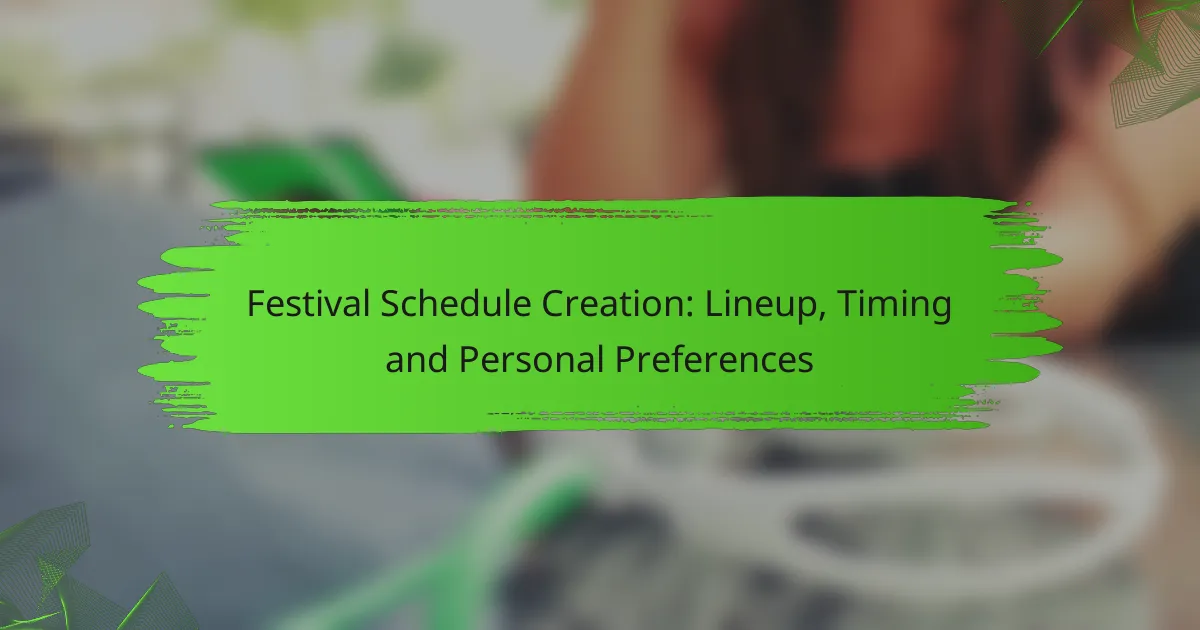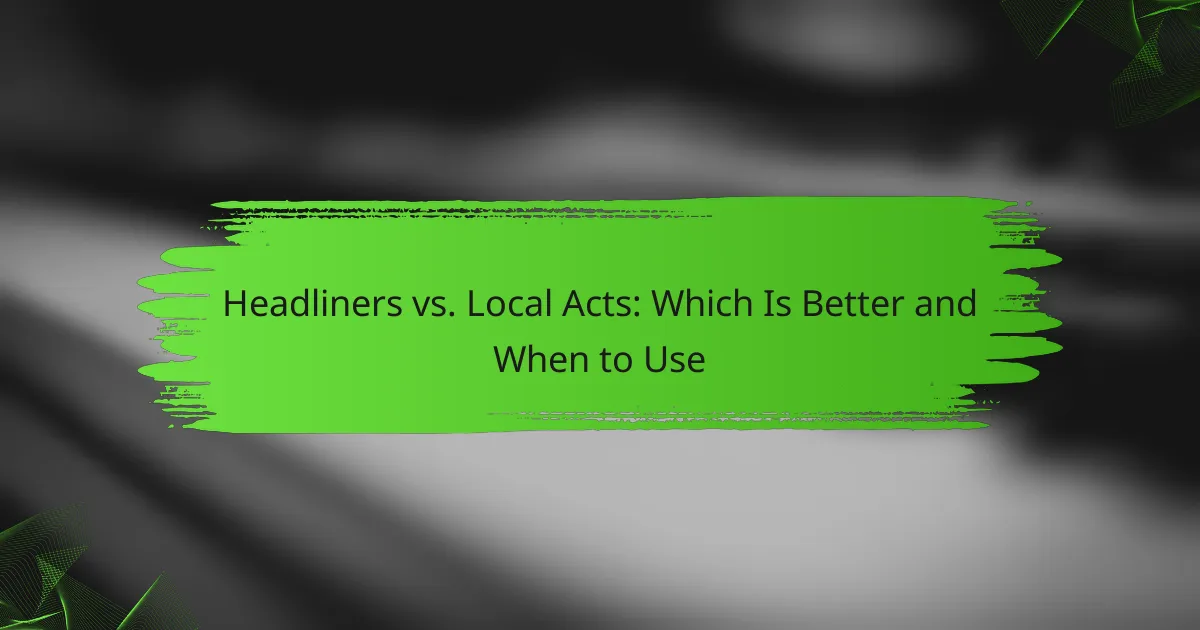Creating an effective festival schedule is essential for maximizing attendee enjoyment and managing time efficiently. By carefully considering artist availability, audience engagement, and personal preferences, organizers can craft a lineup that caters to diverse interests while ensuring a memorable experience for all. A well-structured schedule not only enhances the festival atmosphere but also helps attendees make the most of their time at the event.

How to create an effective festival schedule?
Creating an effective festival schedule involves careful planning to ensure attendees can enjoy key performances while accommodating personal preferences. A well-structured schedule enhances the overall experience and helps manage time effectively during the event.
Identify key performances
Start by pinpointing the main acts that are likely to draw the largest crowds. These performances should be prioritized in your schedule to maximize attendance and engagement. Consider headliners, popular local artists, and unique acts that may attract specific audiences.
Make a list of these key performances, noting their set times and stages. This will help you visualize the overall flow of the festival and ensure that attendees have the opportunity to see their favorite acts without conflicts.
Determine optimal time slots
Assign time slots based on the expected duration of each performance, allowing for transitions between acts. A typical performance might last anywhere from 30 minutes to an hour, with 15-30 minute breaks in between for setup and crowd movement.
Consider peak times when attendees are most likely to be present, such as late afternoon and evening. Avoid scheduling multiple high-demand performances at the same time to prevent audience overlap.
Incorporate personal preferences
Gather input from potential attendees regarding their favorite artists and preferred genres. This can be done through surveys or social media engagement. Understanding personal preferences will help tailor the schedule to meet the audience’s desires.
Be flexible in accommodating various tastes, possibly by offering alternative performances or activities during overlapping times. This ensures that all attendees can find something enjoyable, even if they miss a key act.
Utilize scheduling tools
Leverage digital scheduling tools and apps to create and share the festival lineup. These tools often allow for real-time updates, helping you manage changes effectively. Popular options include Google Calendar, Trello, or specialized event management software.
Ensure that the schedule is easily accessible to attendees, whether through a festival website, mobile app, or printed handouts. Clear communication of the schedule helps attendees plan their day and reduces confusion.
Adjust for venue logistics
Consider the layout of the festival venue when creating the schedule. Factors such as stage proximity, crowd flow, and accessibility can impact how performances are timed. Ensure that transitions between performances allow for safe and efficient movement of attendees.
Account for potential logistical challenges, such as sound bleed between stages or limited access points. Adjusting the schedule to mitigate these issues will enhance the overall experience and keep the festival running smoothly.

What factors influence festival lineup timing?
Festival lineup timing is influenced by several key factors, including artist availability, audience engagement, venue capacity, and weather considerations. Each of these elements plays a crucial role in determining when performances are scheduled to maximize attendance and enjoyment.
Artist availability
Artist availability is a primary factor in scheduling festival lineups. Many performers have busy touring schedules, and their participation may depend on the dates of the festival. It is essential to confirm artists’ availability well in advance to avoid last-minute changes that could disrupt the lineup.
When planning, consider reaching out to artists or their management teams early, ideally several months before the event. This proactive approach allows for better negotiation and increases the likelihood of securing desired acts.
Audience engagement
Audience engagement is vital for a successful festival, and timing can significantly impact attendance. Scheduling popular acts during peak hours, such as evenings or weekends, can draw larger crowds. Additionally, understanding audience demographics helps tailor the lineup to their preferences.
Consider conducting surveys or analyzing past attendance data to identify which time slots resonate most with your target audience. Engaging with fans through social media can also provide insights into their preferred artists and performance times.
Venue capacity
Venue capacity directly affects how many attendees can be accommodated at a festival. Larger venues may allow for overlapping performances, while smaller spaces might require staggered scheduling to manage crowd flow. Understanding the venue’s layout and capacity limits is crucial for planning the lineup effectively.
Ensure that the timing of performances allows for smooth transitions between acts, especially in venues with limited space. This can prevent bottlenecks and enhance the overall festival experience for attendees.
Weather considerations
Weather can significantly impact festival timing, especially for outdoor events. Rain, extreme heat, or other adverse conditions may necessitate adjustments to the schedule to ensure the safety and comfort of attendees and performers. Monitoring weather forecasts leading up to the event is essential.
Consider building flexibility into the schedule, such as having backup indoor venues or adjusting performance times based on weather predictions. Communicating any changes promptly to attendees can help maintain engagement and satisfaction throughout the festival.
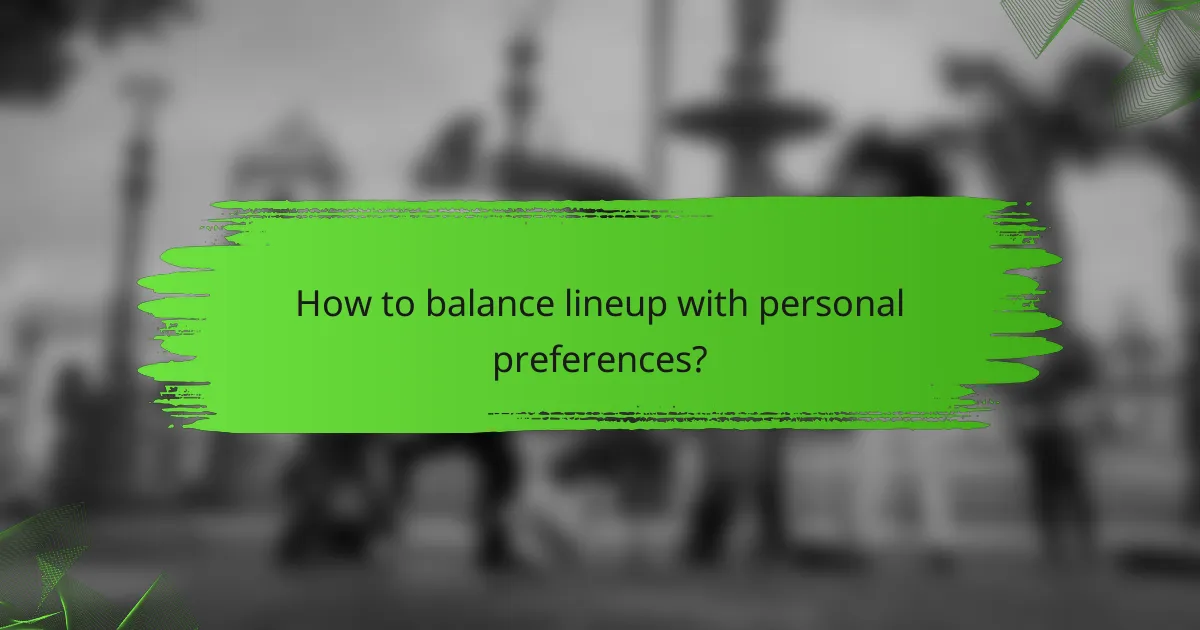
How to balance lineup with personal preferences?
Balancing the festival lineup with personal preferences involves understanding attendee interests while ensuring a diverse range of performances. This approach enhances overall satisfaction and encourages a vibrant atmosphere.
Survey attendee interests
Gathering insights on attendee interests is crucial for creating a lineup that resonates with the audience. Use surveys or polls to identify favorite genres, artists, and performance times. This data helps prioritize acts that will attract larger crowds.
Consider distributing surveys through social media platforms or festival websites. Aim for a response rate that captures a representative sample of your expected audience, ideally targeting at least 20-30% of ticket holders.
Prioritize must-see acts
Identify and prioritize must-see acts that are likely to draw significant interest. These are typically well-known artists or bands with a strong following. Schedule these performances during peak times to maximize attendance.
Balance the lineup by placing these headliners alongside emerging artists, allowing for a mix that appeals to both mainstream and niche audiences. Avoid scheduling multiple high-demand acts simultaneously, which can split the audience.
Incorporate genre diversity
Incorporating genre diversity in the lineup ensures that there is something for everyone, enhancing the festival experience. Aim for a mix of genres such as rock, pop, electronic, and local music to cater to varied tastes.
Consider allocating time slots that allow for genre transitions, helping attendees discover new music. A well-rounded lineup can increase overall attendance and encourage attendees to stay longer, enhancing their festival experience.
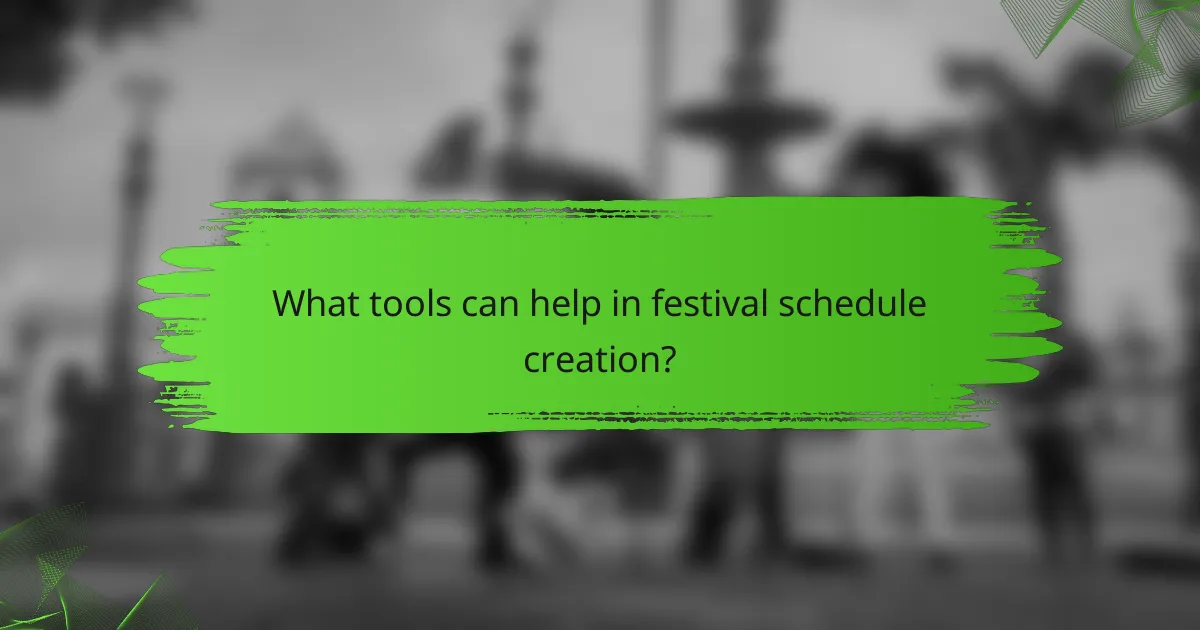
What tools can help in festival schedule creation?
Various tools can significantly aid in festival schedule creation by streamlining the lineup, timing, and personal preferences. Utilizing event management software, online scheduling platforms, and mobile apps can enhance organization and communication for both organizers and attendees.
Event management software
Event management software provides comprehensive solutions for planning and executing festivals. These platforms typically include features for scheduling, ticketing, and attendee management, allowing organizers to create detailed schedules that can be easily adjusted as needed.
When selecting event management software, consider factors such as user interface, integration capabilities with other tools, and customer support. Popular options include Cvent, Eventbrite, and Whova, which cater to various festival sizes and types.
Online scheduling platforms
Online scheduling platforms offer a user-friendly way to create and share festival schedules. These tools allow organizers to display event times, locations, and lineups in a visually appealing format, making it easy for attendees to navigate the festival.
Look for platforms that allow for real-time updates and easy sharing via social media or email. Tools like Google Calendar and Doodle can be effective for smaller events, while larger festivals might benefit from dedicated solutions like Sched or Lineup Ninja.
Mobile apps for real-time updates
Mobile apps are essential for providing real-time updates during festivals. They can notify attendees of schedule changes, highlight important announcements, and offer personalized schedules based on user preferences.
When choosing a mobile app, ensure it supports push notifications and has an intuitive interface. Apps like FestivAll and Eventbase are designed specifically for festivals, allowing users to customize their experience and stay informed throughout the event.
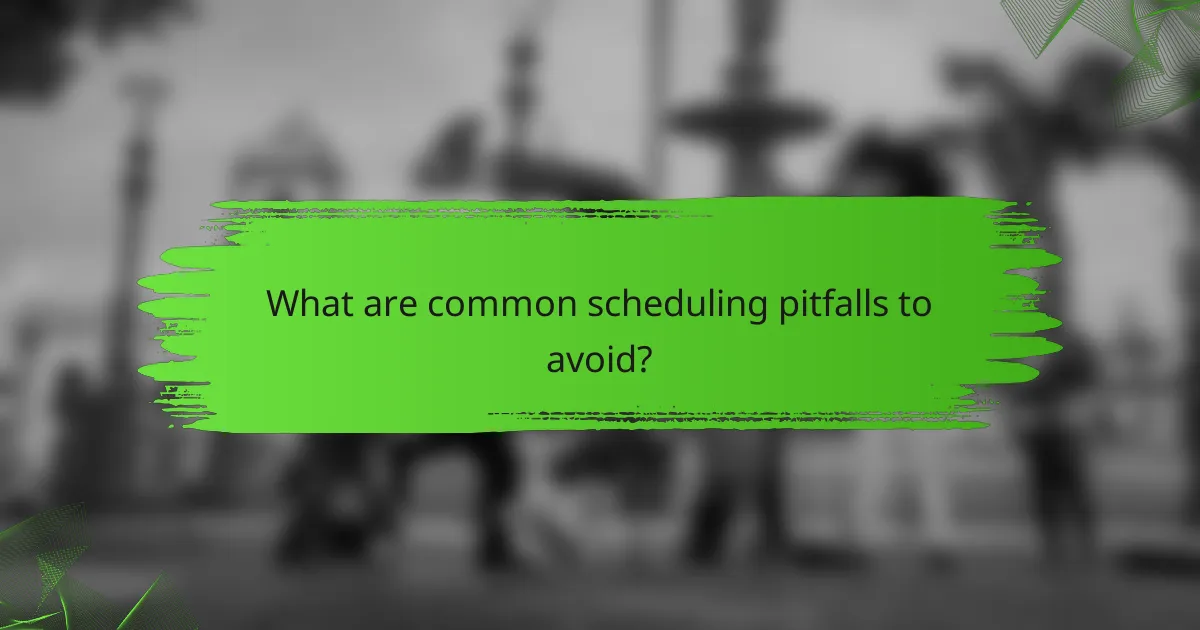
What are common scheduling pitfalls to avoid?
Common scheduling pitfalls include overlapping performances, ignoring audience flow, and neglecting breaks and downtime. Avoiding these issues can enhance the overall experience for attendees and ensure a smoother festival operation.
Overlapping performances
Overlapping performances can frustrate attendees who want to see multiple acts. Schedule acts with enough time between them to allow for transitions, especially if they are on different stages. A good rule of thumb is to leave at least 15-30 minutes between performances to accommodate crowd movement and setup.
Consider using a staggered schedule where popular acts are spaced out to prevent bottlenecks. This way, attendees can enjoy a variety of performances without feeling rushed or missing out.
Ignoring audience flow
Ignoring audience flow can lead to congestion and a poor experience. Analyze the layout of the venue and anticipate how attendees will move between stages, food vendors, and rest areas. Use clear signage and staff to guide the audience and minimize confusion.
Design the schedule to account for peak times when crowds are likely to move, such as right before and after major performances. This can help distribute foot traffic more evenly and keep pathways clear.
Neglecting breaks and downtime
Neglecting breaks and downtime can lead to audience fatigue and dissatisfaction. Schedule short breaks between performances to give attendees time to rest, grab food, or socialize. A break of 10-15 minutes can significantly enhance their overall enjoyment.
Additionally, consider incorporating downtime into the schedule for artists to prepare for their next set. This ensures that performances are of high quality and that artists are not rushed, contributing to a better festival atmosphere.
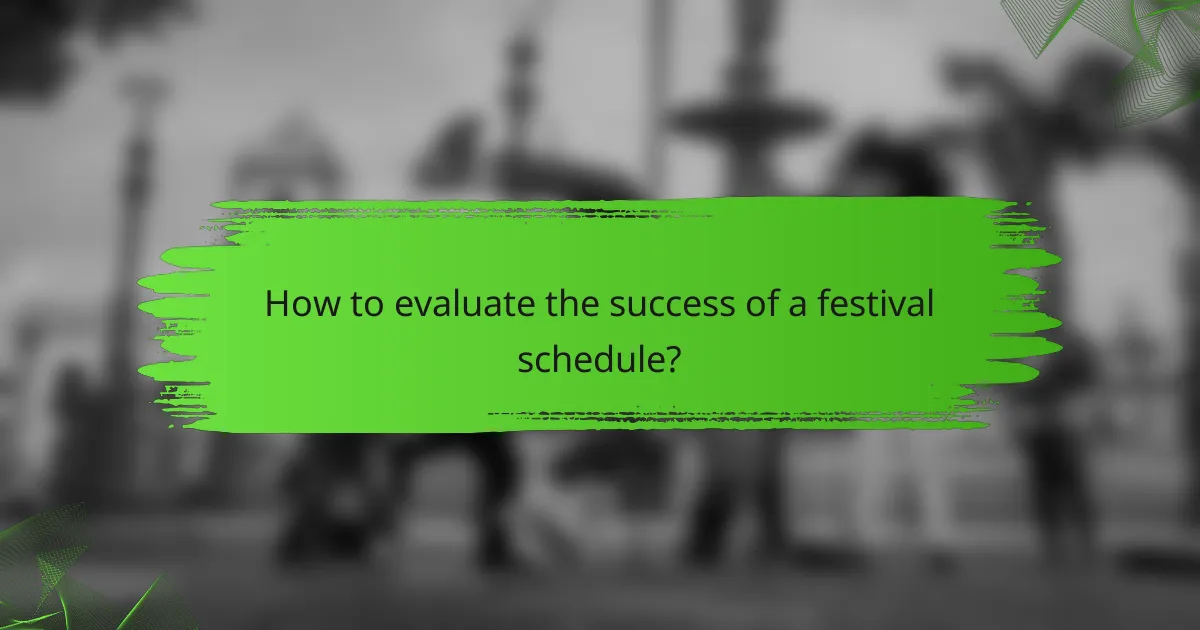
How to evaluate the success of a festival schedule?
Evaluating the success of a festival schedule involves assessing audience satisfaction, attendance figures, and the overall flow of events. Key metrics include ticket sales, participant engagement, and feedback from attendees.
Audience Satisfaction
Audience satisfaction is a crucial indicator of a festival’s success. Gathering feedback through surveys or social media can provide insights into what attendees enjoyed and what could be improved. Aim for a response rate of at least 20% to ensure a representative sample.
Consider using a simple rating scale for various aspects, such as lineup quality, timing, and venue experience. This quantitative data can help identify strengths and weaknesses in the schedule.
Attendance Figures
Attendance figures are a primary measure of a festival’s success. Comparing actual attendance to projected numbers can reveal how well the schedule attracted participants. A successful festival typically sees attendance within 80-120% of its target.
Tracking ticket sales over time can also indicate interest levels. Early bird sales often reflect the initial excitement, while last-minute sales can suggest effective marketing or a strong lineup.
Event Flow and Timing
The flow and timing of events significantly impact the overall experience. A well-structured schedule allows for smooth transitions between acts, minimizing downtime. Aim for 15-30 minute breaks between performances to allow attendees to refresh and navigate the venue.
Consider the overlap of genres and the pacing of high-energy versus low-energy acts. Balancing these elements can enhance audience engagement and retention throughout the festival.
Feedback and Adjustments
Post-festival feedback is essential for continuous improvement. Analyze survey results and social media comments to identify common themes. Look for actionable insights that can inform future scheduling decisions.
Implementing changes based on feedback, such as adjusting set times or enhancing amenities, can significantly improve the experience for future attendees. Regularly revisiting and refining the schedule based on past evaluations will contribute to long-term success.
